For more information:
Note that the latest stuff may not yet be indexed.
The Klezmer Shack directory of articles
This is what I wrote and first put on the main KlezmerShack page in 2000. I periodically pulled capsule reviews out and put them in their own files, but for this last cleanout, I thought I'd leave everything in place, and reference musings, reviews, and all.
3 Dec 00: Before I get into my own bit of writing for the day, I want to note Seth Rogovoy's latest article, a delightful survey of the wide range of Jewish music available these days, New Jewish music for the global village. I don't think this is the first time Rogovoy has written about music beyond klezmer, but while I've been writing more and more over the last three or four years about new Jewish music in a widening variety of areas, it is only now that other writers are picking up on what is happening beyond the sphere of klezmer. I think, in part, we're now seeing the fruits of trees planted as one result of the Klezmer Revival--that having found one form of exciting Jewish music, not only did people branch out into discovering Yiddish culture and Jewish American history in general, but also began exploring the wide variety of Jewish music that is already accessible. We've also been very lucky in the wealth of Sephardic cultures: from the Balkans and North Africa and Yemenite culture available in this country, and in Israel, especially. I mention this a bit more in a quick mention of Tim Sparks' music, later in today's segment, and 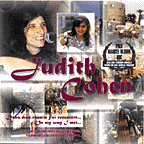 this also provides a nice segue into Steve Fischbach's review of Judith Cohen's most recent work, "Dans mon chemin j'ai rencontré" and a discussion of those fuzzy words, "tradition" and "Sephardic."
this also provides a nice segue into Steve Fischbach's review of Judith Cohen's most recent work, "Dans mon chemin j'ai rencontré" and a discussion of those fuzzy words, "tradition" and "Sephardic."
In a different direction, entirely, Peter Saltzman has set some Jewish texts to an interesting stew of classical, jazz, and blues music. Called "Kabbalah Blues / Quantum Funk" the excursion is a lively and interesting fusion of those music styles. Where I find myself a bit dubious at the first couple of listenings is the claim: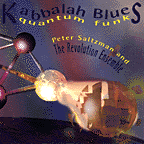
It encompasses the groove of contemporary American urban music, the improvisational freedom of jazz, the structural complexity and tonal color of classical music, the raw energy of rock, the irreverence of the avant-garde, and the lyricism of popular American song. And it is all tied together with themes from Kabbalah and Jewish liturgy. If you're looking for Klezmer, or Israeli folk/pop, you won't find it here (not that there's anything wrong with either of those!) What you will find is a creative, exhilarating, and cutting-edge music that brings Jewish ideas into a modern musical world.
So far, the music is everything Saltzman says it is--it is lively and interesting and very well-performed. But the Jewish connection feels weak. How can you tie something togehter with "themes from Kabbalah and Jewish liturgy" if those do not represent something with which you are even passing familiar? The texts are sung by someone who clearly doesn't understand Hebrew, an impression strengthened by the presentation of the "Oseh shalom" ("May the creator who makes peace") prayer on the back of the CD, in Hebrew misspelled in several places. That the idea of Jewish texts is motivating some of this piece is undeniable--and is certainly the right of the artist to claim or not to claim, not the right of someone else to second-guess. But I am reminded of the prohibition against learning Kaballah until one is 40--until one has not only thoroughly studied other texts, but one has presumably also been imprinted within the community (Elie Wiesel makes a familiar reference to this in his autobiographical book about surviving the camps, "Night"). To appropriate texts in ignorance, but with good intent, surely leads somewhere, and is often a sign of good intent that may in time lead not only to the interesting American music presented here, but something more recognizably tied to Jewish culture.
I'm trying to convince myself that I am over-reacting, in part because the CD is a very nice fusion of musics. But the texts do make me curious. Several times in the accompanying promotional texts reference is made to the idea that there is a connection between the love of God [for Israel, presumably, based on the texts presented] and the love between a man and a woman. This is, indeed, fertile and very Jewish ground. After all, isn't that the point of Solomon's "Shir Ha-shirim" (Song of Songs)? -- or, as many of us liked saying, that would be the point if it hadn't scared the rabbis so much that they had to actually articulate that Song of Songs wasn't to be read literally, but could only be understood as an allegory for God's love of Israel! The hasidim of Tzfat went further. To them, the divine presence (among lots of other things) was divided into male and female aspects, of which the Shekhina was the female aspect who lived in exile from the male except on the Sabbath, when they would leave Tzfat, walking out to welcome the Sabbath bride...." So, one is somewhat at a nonplus to discover that a 20th century musician has discovered such a connection, however much he may have trouble articulating in his texts or writings, how that might have come to be. However he got there, he got to a familiar place and has come to familiar conclusions.
I don't want to sound as though I am encouraging a return to the most insular and cultish forms of Judaism. But surely there is a lot of room to learn and live and make a way of life between ignorance and haredi (ultraorthodox Jewish cultist). My hope is that this music represents an intellectual consideration that will, one day, be as exciting as the music that binds the works' inevitably-banal texts--banal not because they are bad prose or poetry, but because in the light of the wealth of imagery and depth of meaning available in traditional texts, this is barely skimming the surface.
And that's it, for the meta discussion, for now. But, coming soon, a really special article on creating new Jewish music by one of my favorite practitioners of same. Stay tuned! And, as usual, your thoughts are welcome. Send me E-mail with any comments or suggestions.
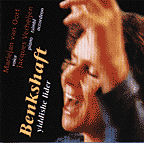 2 Dec 00: The arrival of new music is an almost daily excitement here. Today's mailbag, for instance, brings an exquisite new album, "Benkshaft," featuring Mariejan van Oort's singing and Jacques Verheijen on piano, tsimbl, and accordion. When the duo's first album, "Brikele," came out three years ago, Josh Horowitz pointed them in my direction. I was blown away by van Oort's voice, by the quiet beauty of her singing, and by the perfect understatement achieved by Verheijen, accompanying. In recent years, only Adrienne Cooper's "Dreaming in Yiddish" has given me so much pleasure in this area.
2 Dec 00: The arrival of new music is an almost daily excitement here. Today's mailbag, for instance, brings an exquisite new album, "Benkshaft," featuring Mariejan van Oort's singing and Jacques Verheijen on piano, tsimbl, and accordion. When the duo's first album, "Brikele," came out three years ago, Josh Horowitz pointed them in my direction. I was blown away by van Oort's voice, by the quiet beauty of her singing, and by the perfect understatement achieved by Verheijen, accompanying. In recent years, only Adrienne Cooper's "Dreaming in Yiddish" has given me so much pleasure in this area.
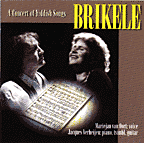 I was not alone in my excitement. Prominent fans, knowledgeable about Yiddish, offered to write about the album, and, as often happens, were then swamped by other projects. (If you saw my review of Charming Hostess/Eat a couple of weeks ago, you will note that I, too, am guilty in this regard.) I am therefore pre-emptively mentioning the new album here, prior to review. I am listening to it as I write, and it is, if anything, better and more satisfying than the first. You can get more info from the website at www.demaatschap.net (dutch and english), or e-mail the duo at jacques.verheijen@planet.nl.
I was not alone in my excitement. Prominent fans, knowledgeable about Yiddish, offered to write about the album, and, as often happens, were then swamped by other projects. (If you saw my review of Charming Hostess/Eat a couple of weeks ago, you will note that I, too, am guilty in this regard.) I am therefore pre-emptively mentioning the new album here, prior to review. I am listening to it as I write, and it is, if anything, better and more satisfying than the first. You can get more info from the website at www.demaatschap.net (dutch and english), or e-mail the duo at jacques.verheijen@planet.nl.
 David Chevan and Warren Byrd have released the follow-up to their 1998 album, "Avadim Hayinu," explorations of Jewish and African-American sacred melodies in a duo (bass, piano) format. The duo, as well as a larger ensemble, the Afro-Semitic Experience, is playing frequently in the Connecticut area and is a pleasure to watch. This album is a pleasureful capturing of that experience. It's jazz, and good listening jazz, but it's also a reminder of shared history and sacred space, something that is good to encounter when done this well.
David Chevan and Warren Byrd have released the follow-up to their 1998 album, "Avadim Hayinu," explorations of Jewish and African-American sacred melodies in a duo (bass, piano) format. The duo, as well as a larger ensemble, the Afro-Semitic Experience, is playing frequently in the Connecticut area and is a pleasure to watch. This album is a pleasureful capturing of that experience. It's jazz, and good listening jazz, but it's also a reminder of shared history and sacred space, something that is good to encounter when done this well.
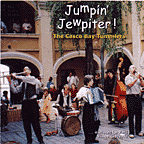 Whenever I think that I have heard one traditional klezmer album too many, and that I don't want to hear anything that isn't radically punk or edgy or elsewhere, someone comes along and does a nice, charming, traditional, heimish album worth listening to. In this case, Maine's Casco Bay Tummlers, fresh back from a tour of Europe, have released a witty, well-played second album of traditional and traditional-inspired Jewish music, "Jumpin' Jewpiter!" Along with traditional instrumentals such as "Freylach Yiddelach" (here played not-so-traditionally on xylophone and reminding some of us of the great San Francisco Marimba Klezmer Band of concerts past, or of the Kleveland Klezmorim), there is delightful verbal byplay in "Mechuteneste Mayne" (My Dear Inlaw) in which a future mother-in-law is warned to treat her new daughter-in-law as her own, and a delightful rendition of Kurt Weill's "Surabaya Johnny". There's a lot here to enjoy, so I'll try to keep it near the CD changer until I've had a reasonable amount of listens.
Whenever I think that I have heard one traditional klezmer album too many, and that I don't want to hear anything that isn't radically punk or edgy or elsewhere, someone comes along and does a nice, charming, traditional, heimish album worth listening to. In this case, Maine's Casco Bay Tummlers, fresh back from a tour of Europe, have released a witty, well-played second album of traditional and traditional-inspired Jewish music, "Jumpin' Jewpiter!" Along with traditional instrumentals such as "Freylach Yiddelach" (here played not-so-traditionally on xylophone and reminding some of us of the great San Francisco Marimba Klezmer Band of concerts past, or of the Kleveland Klezmorim), there is delightful verbal byplay in "Mechuteneste Mayne" (My Dear Inlaw) in which a future mother-in-law is warned to treat her new daughter-in-law as her own, and a delightful rendition of Kurt Weill's "Surabaya Johnny". There's a lot here to enjoy, so I'll try to keep it near the CD changer until I've had a reasonable amount of listens.
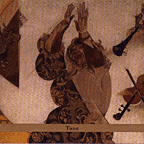 I got e-mail recently from Tzadik recording artist, Tim Sparks, who sent me his two Tzakik releases, last year's "Neshama," and this year's "Tantz." Sparks is an amazing finger-picker whose music reminds me a bit of Dave Grisman, and occasionally of John Fahey or Leo Kotke, except that he's jazzier than them--no less intricate, but more bouncy, more full of life. But my memory is colored by the connection, as we were e-mailing back and forth, that he was the guitarist on a delightful retro-'20s band called "Rio Nido" of whom I was made aware, and of whom I became a fan, back in the mid-'80s. It's a long time later, now. For the recordings in question, on "Neshama" he played a range of Jewish music, religious, Yiddish, klezmer, Ladino, on solo guitar (no vocals).
I got e-mail recently from Tzadik recording artist, Tim Sparks, who sent me his two Tzakik releases, last year's "Neshama," and this year's "Tantz." Sparks is an amazing finger-picker whose music reminds me a bit of Dave Grisman, and occasionally of John Fahey or Leo Kotke, except that he's jazzier than them--no less intricate, but more bouncy, more full of life. But my memory is colored by the connection, as we were e-mailing back and forth, that he was the guitarist on a delightful retro-'20s band called "Rio Nido" of whom I was made aware, and of whom I became a fan, back in the mid-'80s. It's a long time later, now. For the recordings in question, on "Neshama" he played a range of Jewish music, religious, Yiddish, klezmer, Ladino, on solo guitar (no vocals). 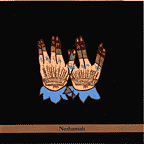 It is good, gentle, listening music with lots there to ponder if you can make the time and space to sit and listen for a while, as I've been doing this evening. Picking up a percussionist and bass player, as he does on "Tantz," gives whole new dimensions to the music, and lets him move away from the melody and improvise more at times, which I really enjoyed. Listening to a guitar stylist who is so deeply influenced by the popular music of the period in which Naftule Brandwein was at his height take on "Wie bist die gewestn vor prohibition?" turns the music on its head in some ways, but also Americanizes Brandwein's Americanized klezmer with results that are unexpectedly accessible and fun. Best, you can still do a tantz (dance) to the result! Here, the range also includes not only the more familiar Yiddish, klezmer, and Sephardic music, but also several Yemenite, Judeo-Kurdish, and even a melody, "Aji tuyorma?" from Azeri Jews from Dagestan. I am presuming, as I look at the range of songs, that he is, or has spent much time in Brooklyn, or someplace with an equally diverse community of far Eastern Jews who came over in the big migrations from the former Soviet Union ten and twenty years ago. Said migrations have given us not only new klezmer and Yiddish repertoire, but opened the door to become familiar with Jewish cultures in the Caucasuses, something different again from the Sephardic and Judeo-Arabic cultures that are more familiar. I had my mind blown just a bit a couple of years ago by the range and vitality of these cultures at a festival feature Jews of the former Soviet Union put on at a community center in Brighton Beach by Brave Old World's Michael Alpert and friends.
It is good, gentle, listening music with lots there to ponder if you can make the time and space to sit and listen for a while, as I've been doing this evening. Picking up a percussionist and bass player, as he does on "Tantz," gives whole new dimensions to the music, and lets him move away from the melody and improvise more at times, which I really enjoyed. Listening to a guitar stylist who is so deeply influenced by the popular music of the period in which Naftule Brandwein was at his height take on "Wie bist die gewestn vor prohibition?" turns the music on its head in some ways, but also Americanizes Brandwein's Americanized klezmer with results that are unexpectedly accessible and fun. Best, you can still do a tantz (dance) to the result! Here, the range also includes not only the more familiar Yiddish, klezmer, and Sephardic music, but also several Yemenite, Judeo-Kurdish, and even a melody, "Aji tuyorma?" from Azeri Jews from Dagestan. I am presuming, as I look at the range of songs, that he is, or has spent much time in Brooklyn, or someplace with an equally diverse community of far Eastern Jews who came over in the big migrations from the former Soviet Union ten and twenty years ago. Said migrations have given us not only new klezmer and Yiddish repertoire, but opened the door to become familiar with Jewish cultures in the Caucasuses, something different again from the Sephardic and Judeo-Arabic cultures that are more familiar. I had my mind blown just a bit a couple of years ago by the range and vitality of these cultures at a festival feature Jews of the former Soviet Union put on at a community center in Brighton Beach by Brave Old World's Michael Alpert and friends.
21 Nov 00: Did I forget to review the charming Charming Hostess CD, "Eat"? Hopefully, all is now remedied and there is still time to get your copy before they go out of print. Band musical director Jewlia Eisenberg has a solo album forthcoming on Tzadik "which is scored for a capella voice and is mostly a setting of the personal writings of Walter Benjamin and Asja Lacis". And while I'm on the subject of amazing fusion music, especially since I'm thinking of dancing, let me plug, once again, the 30 Nov album release party for Klezperanto. This album is going to be everyone's favorite Chanukah present. It is outstanding, amazing, fun, klezmer-derived, and beautifully performed. But you don't have to wait for Chanukah--if you're in the Boston area, just be at Johnny D's on Nov. 30 and your feet will figure it out for you.
14 Nov 00: It's only a month or so before the Jewish response to the solstice, Chanuka!, which comes so late this year such that it even overlaps with the commercial solstice holiday. That means it's time to add a fresh link out to my Chanuka music page. As the holiday approaches, I'll be adding suggestions and reviews from the Jewish-Music mailing list, and whatever else I discover. (On which Flory Jagoda album, for instance, does her wonderful "Ocho candelitos" appear?). If you have ideas, post them to the jewish-music mailing list, or e-mail me.
12 Nov 00: A recent correspondence with Tim Sparks, who has released two albums on the Tzadik label, brought to light an expanded article about his music, which he hosts on this site, "Klezmerized," originally published in Fingerstyle Guitar Magazine, May/June 2000, by Bruce Muckala. I hadn't realized that he was part of "Rio Nido," a favorite of mine in the mid-80s, and a band whose recording of "Midnight in Tunisia" remains a favorite. Berkshire writer, Seth Rogovoy, whose "Essential Klezmer" continues to sell well, has posted two new articles about Pharaoh's Daughter and the religion connection (see also, my own "Jewish Alternative Religion" and review of her most recent album, "Out of the Reeds", this past June), and of Israeli violinist Miri Ben-Ari.
In addition, David Chevan, whose jazz album, Avadim Hayinu, with Warren Byrd, explored Jewish and African-American sacred melodies and their jazz, has released a new CD, Let us break bread together: Further explorations of the Afro-Semitic Experience on the Reckless DC Music label (RMCD-1049). I fell in love at the release concert for the last album. Since I'm still in love, I anticipate enjoying the new album, albeit with fewer personal consequences.
New reviews: Paul Brody's Tango Toy / Klezmer Stories | La Yave: The Key to Sephardic Music | Klezmer Conservatory Band / Dance me to the end of love | Ensemble DRAj / Lieder aus den Ghettos | Tennessee Schmaltz / Old Country Klezmer | Gypsy Jive Band / Dance Me | Closet Klezmer | Einstein's Little Homunculus / Balancing Act | Stewart Curtis' K-Groove / Smoked Salmon Salsa | Lenka Lichtenberg / Deep Inside | Majer Bogdanski / Yiddish Songs--Yidishe Lider | Shawn's Kugel / Most Precious of Days | Brandeis-Bardin International Klezmer Ensemble | Andrew Coleman / Disco by Night
5 Nov 00: This is the time of the fall when I realize that schoolwork is hopelessly behind, when work heats up to a new product release, and there isn't the time there should be to write about Klezmer, much less actually attend concerts. Nonetheless, if you live in Washington, DC, I call your attention to a concert next weekend by Klezcentricity. Not only does the band include David Julian Gray, survivor of the band (the Klezmorim) whose performances may have done more to kick of the klezmer revival than those of any other, but Wendy Morrison, she of the indefatiguable accordion. But there's more. There will be dance instruction! I cannot emphasize how neat this seems to me. I live in New England, near Boston, and there are dance sessions every week for everything from Balkan to English Country Dancing. And they all feature teaching at the beginning, for those, like me, who can't remember steps, or don't know steps. This is so much fun, and so important, yet here in New England we haven't made it happen yet. In DC, they're doing it, and they're throwing in the lindy for good measure. I say it's almost worth flying down to Washington DC for the music and/or the lessons and dancing--take your pick.
New review: Klezroym / Sceni
22 Oct 00: Heiko Lehmann is known to many people in the klezmer scene as a klezmer musician, as a collaborator with Michael Wex, and, least important to many, as a non-Jew. He just spoke at the WOMEX festival in Berlin (Oct 19 2000) about Klezmer in Germany/Germans and Klezmer: Reparation or Contribution. I am pleased to help publicize this text. This is one more part of a long, and likely to be longer-running conversation from which I think we will all learn about ourselves, about "the other," and, of course, about the music. Thank you, Heiko.
Here are a couple of pieces of news that I think we'll all find fun. First, from Britain comes word of a new organization, YaD:
I write to you on behalf of YaD, an organisation which promotes contemporary Jewish arts in Britain. We provide opportunities for artists of all kinds to draw their roots into their work and to explore their dual identity. At the same time we aim to introduce a rich ethnic culture into multi-cultural Britain by putting on high quality, inclusive events.
We launched in June with a live music night of radical Jewish culture called 'Naming the Golem' in the Rhythm Factory, a club in the east end of London putting on Matt Cooper (Outside - Dorado), Jamie Lexton (Kid Loops-Filter), djs, installation and performance artists and a 14 piece electro-folk ensemble from Budapest called Space BeshODroM. Our future plans include more Golem nights (our next is north-african based event), several film events at the Institute of Contemoorary Arts in London, a high-profile touring art exhibition of well-known commissioned artists and a large outdoor event in town next July.
Our site shall be the cyber events listings for YaD. However it shall also be a massive part of our agenda. We intend to run e-exhibitions at the same time as our real art exhibitions, to have clips of the films and music from artists we are working with, and eventually to run our record label through the site.
We are great fans of the Klezmershack site both visually and in its content and think that both sites would benefit from contact with each other. Here is the address of site which is under construction and still lacking a great deal of content and images. However, I hope that it will give you the general idea about its final look. www.yadarts.com. For info, contact links@yadarts.com.
Indeed, the site looks quite interesting. I hope to have the group listed in the "Organizations" section of the site shortly, and presumably checking their "taster" site is an excellent idea, both in terms of things that might be done elsewhere, and for UK readers, especially.
But, that's not why I started to write this today. Frank London, he who never sleeps because he's too busy with too many damn good projects in too many areas to cover fairly, has come up with another project:
I have a new CD coming out in late November. It's called Invocations. It's on Tzadik, and it's all hazonos (cantorial). Settings of classic cantorial works - Rosenblatt, Sirota, Chagy, Kapov Kagan, etc - with my trumpet as the cantor. Recorded live at the Community Synagogue on East 6th Street, with harmonium, some bass, and some glass harmonica! I'm on a new path (it's the total inverse of Di Shikere Kapelye). In addition, i'll be giving the premiere concert at New York's Merkin Hall on Dec. 19, right before Hanukah. Anthony Coleman and Ken Filiano (from the CD) will be joining me. Part of my deal there is that i have to do the promotion for the concert, and I'd really like it to be a success....
So, spread the word about the Dec. 19th concert, and keep your eyes peeled for a very interesting new recording. If you have any ideas for publicizing the concert via the Internet, do it! Then tell your friends and have them do it and elaborate on it, too.
21 Oct 00: There is a lovely link to us from CNN today, as the general Klezmer resource for an article about Klezmer! I guess this goes to prove what I've been saying the last couple of years. It's not cutting edge any more. It's downright mainstream :-). Now, maybe some of the musicians will start to be able to earn there living at this mainstream.... We'll see. But on a smaller level, I also thank CNN for the link. I wish I were finished the face-lift/database project so the place look less chaotic. But that's the way it goes. Guests don't necessarily show up when you're lonely. If you're a visitor from CNN, draw up your ears and explore.... Let me know where you think the site should improve. Send me E-mail with any comments or suggestions.
As to the origins of this klezmer revival, I would love to point first to reminisces by members of the Klezmorim, arguably the most immediately influential of the revival bands (over time, the Statman/Feldman album is probably the one that people learned by heart, but it was the Klezmorim touring, playing the music, making it fun, "outing" klezmer music for millions of people, that laid the groundwork. My own article on the revival, from several years ago, is also available.
 25 Sep 00:The best news is that the long-awaited Klezperanto CD is out. For those who have missed the ongoing chorus of excited listeners, Klezperanto is a klezmer/world folk fusion band on par with, say, the Brave Combo, but, frankly, better and more danceable. If your music taste ranges from South America to the Balkans, with a healthy dose of klezmer fueling it all, this is the band for you. We drove to the Canadian Maritimes this summer with a pre-release tape of this album, and the only thing we listened to near' as much was Buddy McMaster's new fiddle cassette (appropriate, given that we were on Cape Breton when we picked it up).
25 Sep 00:The best news is that the long-awaited Klezperanto CD is out. For those who have missed the ongoing chorus of excited listeners, Klezperanto is a klezmer/world folk fusion band on par with, say, the Brave Combo, but, frankly, better and more danceable. If your music taste ranges from South America to the Balkans, with a healthy dose of klezmer fueling it all, this is the band for you. We drove to the Canadian Maritimes this summer with a pre-release tape of this album, and the only thing we listened to near' as much was Buddy McMaster's new fiddle cassette (appropriate, given that we were on Cape Breton when we picked it up).
But, there's even better news. The band's label, Naxos, is an international company which produces first quality full-length CDs at budget prices. "Klezperanto!" is available at the incredible price of $6.99 (cheap!). At this price, you'd do well to be thinking about purchasing the album by the dozen and making your friends (you'll have lots of friends once you begin handing out copies of this album) happy.
Elsewhere on the KlezmerShack, we are please to present "Yiddish song: an A-Z of research", a lovely annotated bibliography of Yiddish song references, including publications that include the texts of Yiddish song. Written by UK doctoral candidate Abbi Wood this should make a great starting point for students around the world exploring Yiddish song.
Last month I attended yet another fun religious bat mitzvah. In this particular case, the honoree roped in her friends to play DJ, and arranged several sets of music for the various attendees. There was the klezmer set, for instance, which featured mostly re-released '78s--we were busy dancing or I would have asked if this was due to preference, or lack of available disks. There was also the obligatory older Israeli folk dance set where mom and those of us that age got to relive "sovi sovi mamtera" and other classics of early Israeli folk dancing. But the part that I enjoyed the most was the techno-influenced religious dance music that I have seen at many simkhas over the years, to which the girls (almost exclusively the girls) did all sorts of (spontaneously?) choreographed movements. It was like watching several lines of Rockettes, except that the dance was very much for fun, and much more interesting. I've noticed this music (I think it started with Schlock Rock, but things have gone far beyond that, now) for the past decade, and especially noticed it because of the girls' dancing. The music is now an amalgam of hasidic, Mizrahi, and techno, and it seems to be exclusively an Orthodox style--I don't see it at other kids' events. And it's always an excuse for the girls to have fun with choreographed motion. If anyone knows more about this phenomenon and would like to write about it, the KlezmerShack would love to post about it. Send me E-mail. Last revised 29 April, 2012.
Saturday night I caught the final event in a three-day residency by David Krakauer at Brandeis University. He performed Osvaldo Golijov's "The Dreams and Prayers of Isaac the Blind" with the university's Lydian String Quartet (who also did a dynamite Shostakovich String Quartet in the first half). I have to reiterate what I hope I said in my review of the recording Krakauer did of this piece with the Kronos Quartet, that this is a delightful piece of music. Krakauer's playing--the focus and intensity and unbelievable perfection of his playing--were stunning. The Lyds did a good job of working with him, although there were places in the second movement where I felt that his playing so overwhelmed what they were doing that you could tell that there was a counter-melody in there somewhere, but darned if you could make it out. This should not be heard as more than a minor quibble, however. This piece is a delight, the Kronos Quartet recording was a pleasure, but seeing it performed was even more. A thrill.
After the concert I spoke with Krakauer briefly about music, his plans, and the usual. He has a new klezmer album coming out shortly on a French Jazz label, which should become available here in the States in the spring. We talked about various Jewish music, but he emphasized that his interest, and his focus, is on klezmer, and on ways to express that way of music (saying "style of music" seems to tame for the clarity with which he ignored attempts at asking about other influences and repeated that what he was interested in was in playing klezmer, specifically). This is different from what other musicians who have recorded with John Zorn's "Radical Jewish Culture" label seem to be saying with their music. Anthony Coleman, for instance, or Uri Caine, are exploring much traditional Jewish music, more often nigun and nusakh, than klezmer or folk song. The same could be said for Pharoah's Daughter or Gary Lucas. Even Naftule's Dream, which comes from klezmer, would be better described as "post-klezmer," and sees that side of the band as a place to explore much more. For many of these musicians (but certainly not all), "Radical Jewish Culture" refers to an attempt to grapple with "Jewish" through music, and "Jewish" has many musical meanings. Krakauer, however, is a klezmer. Anyone who has heard his recordings, or his performances, will likely enthusiastically approve.
Krakauer also talked a bit about his weekly klezmer brunches at the Tonic: "I was in Berlin where you could hear klezmer every night of the week, and I felt that in New York you should be able to hear klezmer at least once a week!" The Tonic brunches, of course, have become the best thing to do on a Sunday afternoon in New York, and have presented a wonderful diversity of klezmorim, from the traditional to the avant garde.
One additional lovely element of the performance was the presence of the piece's author, Osvaldo Golijov, who now lives in Newton. I would love to add insight into the piece, such as why he described the first section as "Aramaic," and the third as "Hebrew," when the clarinet music in all three parts seemed much more klezmer than otherwise. Is this because at the premier with Giora Feidman, or on the Kronos Quarter recording, and Saturday night, the clarinetists were so emphatically connected to klezmer, or was his intent as we heard it, and the selection of soloist mirroring the author's intent? As it happened, however, our main concern was to convince him to help get the Jewish Community Orchestra moving again, and to help bring the Argentinian duo, Klezmer en Buenos Aires, to Newton. And, of course, to thank him for a wonderful piece of music.
23 Jul 00: As I clear through weeks of e-mail and add several good articles to the KlezmerWords section (in addition to listing first bands from Spain and from Sweden), I notice that Ilene Stahl's acclaimed Klezperanto, Boston's latest world fusion klezmer band, has a CD coming out on Naxos this fall. This is exciting, and further proof that Boston is the place to listen to Klezmer of all stripes, colors, and always, always, danceability. (This is the same town that's hosting a free Bessarabian Klez Concert with German Gorenberg next week--see the calendar.). What with a new Klezmer Conservatory Band album just hitting the stores, it's a good summer for klezmer, here. That being said, there was nothing to do but clear the decks by catching up on reviews of the most recent Naftule's Dream ("Smash, Clap!") and Shirim ("Oy, It's Good") albums, and while I was at it, to contemplate some Polish klezmer from Kroke ("Sounds of a vanishing world").
22 Jul 00: Have I mentioned that the Klezmorim, the band often credited with kicking off the "klezmer revival" of the '70s and '80s, now has its own website? Do visit (and link to it): klezmo.com.
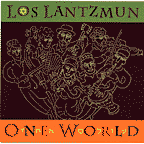 Denver-based "Los Lantzmun," featuring Hebrew book designer extraordinaire, Hal Aqua, has released it's first CD, "One World." The CD is a pleasant mix of klezmer, Israeli, Sephardi, Chasidic, Yemenite and other traditional religious tunes, similar in repertoire and approach to Vancouver's Tzimmes. It is, in short, a very representative sampling of American Jewish music! You can check out a copy cdbaby.com.
Denver-based "Los Lantzmun," featuring Hebrew book designer extraordinaire, Hal Aqua, has released it's first CD, "One World." The CD is a pleasant mix of klezmer, Israeli, Sephardi, Chasidic, Yemenite and other traditional religious tunes, similar in repertoire and approach to Vancouver's Tzimmes. It is, in short, a very representative sampling of American Jewish music! You can check out a copy cdbaby.com.
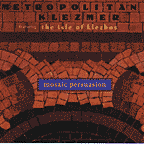 In addition, I've just gotten my hands on the new Metropolitan Klezmer album, "Mosaic Persuasion," which also features the all-woman "Isle of Klezbos". If you liked the band's first album, "Yiddish for Travelers" (I liked it a lot!), you'll find the new album deeper, better, and even more fun. Notable are a very swinging "Abi Gezunt" a very cool fusion of Eastern Europe and American Jazz in the "East(ern) Village Hanuka." There's also a version of "Lomir zikh iberbetn" (Let's make up) with entirely different lyrics and weight from the recent Flying Bulgars rendition of a song with the same name and same tune ("Tsirkus"). Damn. Wish I was in the village right now, at a small club listening for this band that is still, clearly worth driving the four hours down from Boston for. At least, that's what the first listen sounds like. There will be many more.
In addition, I've just gotten my hands on the new Metropolitan Klezmer album, "Mosaic Persuasion," which also features the all-woman "Isle of Klezbos". If you liked the band's first album, "Yiddish for Travelers" (I liked it a lot!), you'll find the new album deeper, better, and even more fun. Notable are a very swinging "Abi Gezunt" a very cool fusion of Eastern Europe and American Jazz in the "East(ern) Village Hanuka." There's also a version of "Lomir zikh iberbetn" (Let's make up) with entirely different lyrics and weight from the recent Flying Bulgars rendition of a song with the same name and same tune ("Tsirkus"). Damn. Wish I was in the village right now, at a small club listening for this band that is still, clearly worth driving the four hours down from Boston for. At least, that's what the first listen sounds like. There will be many more.
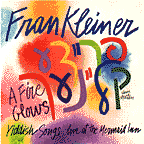 And, rounding out the evening's listening, here is an album of Yiddish folk songs by Fran Kleiner, "A Fire Glows". It's a live performance with the singer and her guitar. Her voice, and her explanations of the songs, are very refreshing, very genuine. I haven't enjoyed folky Yiddish singing this much since I last heard Gerry Tenney and Betty Albert Schreck back in California. The album opens with the familiar "Der Yid der schmid" (The Jewish Blacksmith) and runs through familiar and unfamiliar songs, ranging from the "Partisaner Lid" to "Oyfn Pripetshik" and even "Fisher Lid", which the Klezmatics do somewhat differently. I've been overwhelmed with pretty Yiddish singing on CDs lately. This is pleasantly different, and much easier to keep listening to. This is a real Yiddish family album, but also a good album to listen to just at those moments when you wish your family were around.
And, rounding out the evening's listening, here is an album of Yiddish folk songs by Fran Kleiner, "A Fire Glows". It's a live performance with the singer and her guitar. Her voice, and her explanations of the songs, are very refreshing, very genuine. I haven't enjoyed folky Yiddish singing this much since I last heard Gerry Tenney and Betty Albert Schreck back in California. The album opens with the familiar "Der Yid der schmid" (The Jewish Blacksmith) and runs through familiar and unfamiliar songs, ranging from the "Partisaner Lid" to "Oyfn Pripetshik" and even "Fisher Lid", which the Klezmatics do somewhat differently. I've been overwhelmed with pretty Yiddish singing on CDs lately. This is pleasantly different, and much easier to keep listening to. This is a real Yiddish family album, but also a good album to listen to just at those moments when you wish your family were around.
18 Jun 00: There are some new articles. First, Jonathan Schorsch writes about a wide variety of new Jewish music in "Making Judaism Cool" from an article from the March Tikkun magazine that I just discovered. Next, George Robinson reviews two classic Yiddish comedy sets. In our band listings, I am pleased to announce a band from Beijing, for listing purposes named "Kehillat Beijing Klezmer" as the first klezmer band in China! Finally, I note that the 1979 Andy Statman/Zev Feldman album, "Jewish Klezmer Music" that first got so many of us excited about klezmer has now been rereleased on Shanachie, SHANACHIE 21002. Enjoy!
11 Jun 00: It's been a busy weekend. Josh Horowitz's notes about figuring out the wedding material on the new Budowitz CD, "Wedding with a Bride," which he posted originally last week to the Jewish-music mailing list are now online. There are also several new reviews of albums that I've been listening to over the last few months (Pharaoh's Daughter, Ruth Yaakov Ensemble, Klezmeritis, Flying Bulgars), and a new survey of Sephardic Music is George Robinson's contribution this week.
10 Jun 00: Metropolitan Klezmer, one of my favorite traditional klezmer ensembles, is about to release a new CD, "Mosaic Persuasion." Those who remember the debut album, "Yiddish for Travelers," or who have seen this excellent combo live (or both!) will be most excited. They hope to have copies available at their FREE June 13 concert at the Jewish museum in New York (see calendar). Speaking of calendars, if you live in New York, Boston, or Washington, you had better have tix already to see the Flying Bulgars in a rare performance outside Toronto. This is a band I frequently compare to the Klezmatics for wonderful, innovative melds of Yiddish, klezmer, and world beat music. The albums are stupendous, but live is even better. And their latest album, "Tsirkus," may be the best yet.
30 May 00: An opportunity for a special mitzvah! Swampscott, MA's youth klezmer band has been invited to participate in a very special tour of Eastern European and Israel. You can help. In fact, if you don't help, they can't go! For details, here are bandmember Ben Gerson's article and all details.
New review: Budowitz / Wedding without a bride
 29 May 00: Seth Rogovoy's book on klezmer is now officially out and should be appearing in finer bookstores everywhere. "The Essential Klezmer" appears to be just that: interviews, reviews, history, photos. Should go quite well with Henry Sapoznik's "Klezmer! Jewish Music From Old World to Our World"
(Schirmer Books) which looks to be a wonderful history/gossip of American Jewish music, including the klezmer revival. From glancing through, Seth's looks like the perfect home companion to anyone interested in knowing more about klezmer and the musicians and recordings, compared to Henry's history/memoir. Seth's book has already been cited in at least one music encyclopedia, based on an advance copy that I shared (it shouldn't sit here entirely unread1) I'm hoping to spend some serious catching up time reading both books very soon. Seth will do a reading at the Massachusetts
Museum of Contemporary Art in North Adams, Mass., on Aug. 12 at 4pm; talk to
be followed by a concert by Klezperanto.
29 May 00: Seth Rogovoy's book on klezmer is now officially out and should be appearing in finer bookstores everywhere. "The Essential Klezmer" appears to be just that: interviews, reviews, history, photos. Should go quite well with Henry Sapoznik's "Klezmer! Jewish Music From Old World to Our World"
(Schirmer Books) which looks to be a wonderful history/gossip of American Jewish music, including the klezmer revival. From glancing through, Seth's looks like the perfect home companion to anyone interested in knowing more about klezmer and the musicians and recordings, compared to Henry's history/memoir. Seth's book has already been cited in at least one music encyclopedia, based on an advance copy that I shared (it shouldn't sit here entirely unread1) I'm hoping to spend some serious catching up time reading both books very soon. Seth will do a reading at the Massachusetts
Museum of Contemporary Art in North Adams, Mass., on Aug. 12 at 4pm; talk to
be followed by a concert by Klezperanto.
Elsewhere in the site, I have reviewed two albums that have been in play for a while: La'om's 1998 live recording, "Riffkele", which would have received its due years ago, but for my constant looking for time to write a review worthy of the album. This will have to suffice. And, in the meantime, my favorite Winnepeg klezmer band, Finjan, has fiiiinally followed up a kick-ass CD from 1992 with this year's "Dancing on Water." Since both are unlikely to get local attention, I have tried to substitute. Note that the links to audio samples are not working yet--glitch on my end.
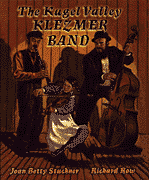 28 May 00: Some time back, I received notice of a children's book written about a would be klezmer. Published by Scholastic Canada, it's called "The Kugel Valley Klezmer Band," (North Winds Press, 1998, ISBN: 0-590-03833-8) by Joan Betty Stuchner and illustrated by Richard Row. It is a very inspired kids story about a little girl who wants to be part of the local klezmer band and who practices and practices.... I'm looking forward to trying it out on a six-year-old for whom it may be perfect age-wise, if perhaps a stretch interest-wise. We'll see. If she's willing, a review will definitely be forthcoming.
28 May 00: Some time back, I received notice of a children's book written about a would be klezmer. Published by Scholastic Canada, it's called "The Kugel Valley Klezmer Band," (North Winds Press, 1998, ISBN: 0-590-03833-8) by Joan Betty Stuchner and illustrated by Richard Row. It is a very inspired kids story about a little girl who wants to be part of the local klezmer band and who practices and practices.... I'm looking forward to trying it out on a six-year-old for whom it may be perfect age-wise, if perhaps a stretch interest-wise. We'll see. If she's willing, a review will definitely be forthcoming.
27 May 00, New reviews: Ghetto Tango | Khevrisa | di Shikere Kapelye
I'm going to promise once again to write about a slew of wonderful klezmer recordings that have arrived here in the last few months, but as I dig out from under amazing recordings ranging from Shawn's Kugel to the Australian Klezmermania and Closet Klezmer and Klezmeritis, I want to mention three especially special recordings that have been much on my mind since their arrival. In these cases, it isn't just the music (and these aren't the reviews these recordings deserve or will get). There is also significance to the recording itself.
7 May 00, New review: Knitting on the Roof
20 Mar 00: From: Henry Sapoznik, Sapoznik@aol.com
Date: Mon, 20 Mar 2000 11:29:39 EST
Subject: Max Epstein (1913-2000)
To: World music from a Jewish slant
Max Epstein, famed veteran klezmer clarinetist and member of the well known Epstein Brothers Orchestra died in Florida yesterday. He was 87.
As the only acknowledged American born equal of such European klezmer players as Dave Tarras and Naftule Brandwein, Epstein enjoyed unparalled success as a working member of New York's Yiddish music community during its heyday in the 1930s and 1940s. He and his brothers recorded a number of records including the classic "Dukes of Freilachland" LP in the late 1950s.
Moving to Flordia in the 1960s, the fame of the brothers diminshed and was only rekindled with the renewed interest in klezmer music in the 1970s. Their retirement was ended by keyboard player Pete Sokolow who encouraged Epstein's appearance at KlezKamp in 1991 where he met clarinetist Joel Rubin. Rubin orchestrated the Brothers' successful tours resulting in the documentary film "A Tickle in the Heart". The Epsteins were later awarded a National Heritage Folklife Award by the National Endowment for the Arts in 1998.
Max Epstein is survived by his wife and brother, drummer Julie.
Henry Sapoznik
Author
"Klezmer! Jewish Music From Old World to Our World"
(Schirmer Books)
13 Mar 00: With apologies for the delays, we now have George Robinson's 1999 Jewish music roundup. George is a frequent contributor to these pages, who also writes for the Jewish Week. This week sees publication of his hardback primer, "Essential Judaism," from Pocket Books. We also have a first person narrative about KlezKamp '99 from Ben Gerson, of the Klezmaniacs (Mass).
12 Mar 00: Some reflections on the new edges: Last night I attended Balkan night, here in the Boston area. It is one of my favorite annual events. The music is wonderful--countries and cultures from Greece and Turkey through Bulgaria up to Hungary are often represented, although this particular year was heavy with bands from Bulgaria. No matter. Imagine an evening where one hears, first, some four bands of extraordinary quality doing short sets of their favorites. Imagine a Boston audience singing along to a Bulgarian folk song. Then imagine ongoing dancing for five hours, as the bands rotate in and out. Needless to say, my personal favorites, Zlatne Uste were there in all of their brassy splendor.
I have been plotting for several months, with friends, to set up just a monthly klezmer gathering; say, a dance tutorial for an hour or so, followed by a music jam and dance. Or, a music jam/tutorial, followed by some dance instruction and a dance party. We're getting close. And one day, I'd love to see a Jewish dance party night, where there are Jewish dance traditions from all over th eplace represented, from the Caucasus through klez and Sephardic traditions. One stumbling block is space. Ideally we'd like to find a hall in which fifty people or more can make music or dance once a month. The hall should be accessible by the city's underground system so that those with no desire or means to drive can participate. We have to be able to serve refreshments, even if these arrive as sealed kosher containers. And someone has to guarantee the money to pay for the hall in case not enough people show up, as may well be the case, initially. If you have any ideas, do e-mail me!
Klezroym | Meshuge Klezmer Band / Dreidel | Full Metal Klezmer
7 Mar 2000: Seth Rogovoy, author of "The Essential Klezmer," (out May, from Algonquin books) sends e-mail that he will do a reading at the Massachusetts Museum of Contemporary Art in North Adams, Mass., on Aug. 12 at 4pm; talk to be followed by a concert by Klezperanto. This should be a lot of fun. The book sounds like the record and music guide that klez-listeners have been looking for, and Klezperanto is threatening to edge my homies, Naftule's Dream, off my favorite klezband list. Seth is, of course, always available for in-store signings and also to present his music talk, "Rockin' the Shtetl: The Essential Klezmer." Email him for more info.
27 February: So many things to catch up on. The most exciting online publication this week is that Susan Bauer's book on Klezmer, "von der Khupe zum Klezkamp" has made its way to the web. Well, Chapter 1 of the book is now online. Unfortunately, the book/CD still hasn't been translated into English. Elsewhere, online, I am pleased to have html-ized George Robinson's wonderful article about women in klezmer (one of several by Mr. Robinson on these pages), as well as Dutch historian Gerben Zaagsma's article on the Jewish musician guild in Prague, now available, exclusively on the web, in English. As usual, the Klezmershack will provide a site, and will even convert to html, any article remotely of interest to our audience. We will also link to articles on your site. The issue is access--if all it takes is a link, that's fine. If it requires more, we'll do what we can to facilitate that access. And, of course, do feel encouraged to do deep linking and link specifically to any page that interests you (we should be so lucky) that is already here!
Frank London / Shekhina | Nigunim | Zohar : Keter
18 January: One of the neat things about the KlezmerShack is the assumption people make that you will want to meet local klezmorim wherever you go. So, it should have come as no surprise, when I let some online friends know that I was on my way to Santa Fe for a conference, that one of them had a brother who happened to be in a klezmer band in town, the Chrabolowski Jewish Orchestra. You may contact Peter Gordon, pglolo@aol.com for information about local bookings. Chrabolowski, if I have the story right, is the name of the grandparent or great-grandparent from Europe. Peter arrived in town a few years ago to teach at a local college, from New York. He started up the band and he was astonished how quickly word spread, leading to the band playing gigs even for the local Lubavitch community, as well as the other local synagogues (who would have thought that Santa Fe would be a hotbed of Jewish community, to boot) and, of course, lots of simkhas. But they're good, and they play klezmer. What's not to hire?
There is a unique Jewish connection to the southwest. Many Catholics in the area are descendents of the original Spanish settlers who migrated north from Mexico, trying to get as far from the Inquisition as possible. About a decade or so ago, there was a whole wave of publicity around people who discovered that they were descended from crypto-Jews--Jews who were forced to convert to Catholicism in Spain, who later migrated, and who passed down a few Jewish customs, always in secret, now for 500 years. The publicity caused more people to connect odd secret rituals their families had practiced for centuries to Jewish ancestry, and it was/is quite a movement. This brings its own topsy turvy--for some people, the knowledge that they may be descended from Jews is irrelevant; for others, it is closure and explains an odd, secretive family custom--but their families have been Catholic for 500 years and they have no reason to change. For a number of others, it has been the impetus to explore Judaism, and their lives are very much changed. Peter told me that the church just up the block from the hotel where I've been staying incorporates a Star of David somewhere in its decor, presumably made part of the construction by a crypto-Jew a century or however many ago when the church was built.
In any event, I met no "out" crypto Jews or descendents thereof. I did hear from many people about the mix of many religions that characterizes part of the Santa Fe gestalt. There are lots of Jewish Buddhists. Lots of Native American religions and non-native American followers of same. Lots of New Agers in all their variety. Lots of Buddhists, Sufis, and the usual Western mix, including a large Jewish community. And I bring this up only because of the astounding quantity of Jewish kitsh in local souvenir windows. We're talking southwest-style ceramics with horribly calligraphed "Shalom" or prayers. Bad art, mostly. Expensive, mostly. I mean, you don't see Jewish stuff this grotesque in general tourist windows in New York, or Boston.
And there's more! You think there's a Jewish craze in Germany. Hah! It's here in Santa Fe, as well. There is even an exhibit of "Jewish Pioneers of New Mexico" opening locally this summer. And just to make sure I understand how deep this is, there is an incident as I'm at a reception for the conference I am attending, talking with friends about how unexpected it is to discover klezmer is a small town that is, to us, the middle of nowhere. In the background is a local flamenco band duo--he dances, she accompanies him on guitar. Suddenly, he begins singing and dancing to "If I were a rich man," which segues into "Hava Tequila" (in my day, it was hava nargila, but perhaps it's better this way), and finally into a spanish number, all the while in perfect flamenco beat and dance. A mechaya! (a pleasure).
So, somebody who knows the southwest should write these pages and tell me more about all of these subjects. And write about the Chrabolowski Jewish Orchestra, who I suspect are very good, and very fun in concert. In return, as you'll note in the first paragraph of today's log, I've given you info to contact the best klezmer band in the area. And the bandleader is a very special mensh. Likes good music--klezmer, balkan musics, avant garde jazz, more. Knows from Yiddish Theatre. Been playing for a long time. Expensive, but worth it.
15 January: Olam | Klezmer En Buenos Aires | Rubinchik's Orchestyr | Khupe | Rabbinical School Droputs
2 January: As I try to catch some news and listings up, I note with pleasure that there is a new label for Yiddish field recordings, "Yiddishlandrecords.com". The label's first project is the release of a delightful collection of songs by one of the few people writing new Yiddish music, Zumerteg by Beyle Schaechter-Gottesman. (A performance of this material at Ashkenaz '97 is also available online). This is something that most readers of these pages will want to check out and rejoice over. A concert celebrating the music, and other rarely-heard Yiddish song, will be at David Krakauer's Tonic series, January 9. Information: 212-358-7501, or e-mail Itzik Gottesman.
Other recent articles that I have found include an e-mail from Miriam Kaul, of The Golem Shuffle, writing of the band traveling to Lublin Poland to headline the Hades Jazz Fest, Dec. 1999. Elsewhere, Seth Rogovoy writes about seeing Wolf Krakowski perform at the National Yiddish Book Center, Dec. 1999. Both of these articles, written originally for friends and posted to the internet, exemplify the power this medium gives us to document the richness of the klezmer scene. I thank these writers, and those on the klezmershack articles page, who continue to report from the front lines and edges, wherever they may be perceived to be. You'll also see a wonderful letter from correspondent Moshe Renert, of Olam about his band's work over the past couple of years on our feedback page.
1 January: What a great way to spend the new goyishe year: listening to the new very soulfully Jewish Margot Leverett / Art of the Klezmer Clarinet!
Previous year's weblog (1999) | Current Klezmershack main page

